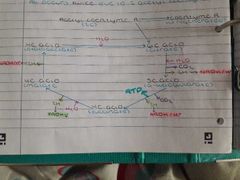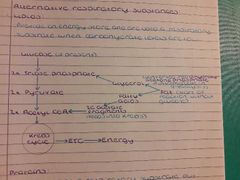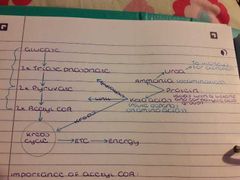![]()
![]()
![]()
Use LEFT and RIGHT arrow keys to navigate between flashcards;
Use UP and DOWN arrow keys to flip the card;
H to show hint;
A reads text to speech;
44 Cards in this Set
- Front
- Back
|
Uses of ATP |
Active transport Muscle contraction Nerve transmission Glycolysis (substrate level phosphorylation) Photosynthesis (light independent reaction) |
|
|
Benefit of ATP |
Allows controlled transfer of free energy from energy rich compounds in small amounts to cellular reactions where energy is needed Only one enzyme required to release energy |
|
|
Amount of energy released from ATP |
30.6 kJ/mol |
|
|
Oxidative phosphorylation |
Occurs on mitochondria membranes in aerobic respiration |
|
|
Photophosphorylation |
Occurs on thylakoid membranes of chloroplasts in photosynthesis |
|
|
Aerobic respiration |
Catabolic process involving a series of enzyme catalysed reactions Energy rich respiratory substrates are broken down |
|
|
How energy is used |
To form ATP or is released as heat |
|
|
Electron carriers |
Are able to carry hydrogen ions and electrons NAD+ + 2H+ + 2e- -> NADH/H+ (Nicotinamide Adenine Dinucleotide) |
|
|
Where does glycolysis occur? |
Occurs in the cytosol of the cell |
|
|
Glycolysis |
Glucose turns into hexose phosphate (6C + 2Pi) on the addition of 2 phosphates (2ATP -> 2ADP) Hexose phosphate splits into 2 triose phosphate molecules (3C + Pi) TP loses 2H+ and Pi to form pyruvate (3C) ×2 NAD+ + 2H+ -> NADH/H+ ×2 2ADP +2Pi -> 2ATP ×2 |
|
|
Net gain of ATP in glycolysis |
2 ATP molecules |
|
|
Type of phosphorylation in glycolysis |
Substrate level phosphorylation (ATP synthesized directly from phosphate compounds) |
|
|
Where the Link Reaction occurs? |
In the matrix of the mitochondria (where all the necessary enzymes are located) |
|
|
How many times does the Link Reaction occur per glucose? |
Twice for 2 pyruvates |
|
|
Link Reaction |
Pyruvate lose a C atom (in the form of CO2) and 2H+ which is catalysed by decarboxlase and dehydrogenase enzymes 2H+ + NAD+ -> NADH/H+ It forms Acetate (2C) which combines with Coenzyme A to form Acetyl Coenzyme A |
|
|
Where does the Krebs Cycle (Citric Acid Cycle) occur? |
In the matrix of mitochondria |
|
|
Function of the Krebs Cycle |
To release energy from carbon bonds via reduced intermediates to produce reduced NAD/FAD |
|
|
How many times does the Krebs Cycle occur per glucose? |
Twice for 2 Acetyl Coenzyme A |
|
|
Krebs Cycle |

|
|
|
Dehydrogenation |
Pairs of H atoms removed from intermediates, catalysed by dehydrogenase |
|
|
Decarboxylation |
Carbon removed from carboxyl group as carbon dioxide from intermediates, catalysed by decarboxylases |
|
|
Where the Electron Transport Chain occurs? |
The inner membrane of the mitochondria |
|
|
How the ETC obtains energy? |
From the hydrogen atoms to NAD/FAD |
|
|
ETC |
Hydrogen is split into H+ and e- from NAD/FAD in the matrix High energy electrons pass along electron carriers and proton pumps in the inner membrane Protons are pumped from the matrix to the intermembranal space (pumps are powered by high energy electrons) Protons diffuse into matrix via stalked particles where ATP is synthesised (catalysed by ATP synthase) Protons recombine with e- to form hydrogen atoms that combine with oxygen (final hydrogen carrier) to form water |
|
|
How many ATPs are synthesised from the oxidation of NAD? |
3 ATP molecules |
|
|
How many ATPs are synthesised from the oxidation of FAD? |
2 ATP molecules |
|
|
Why is there a difference between NAD and FAD? |
FAD releases electrons and protons further down the ETC, leading to them gaining less energy |
|
|
Type of phosphorylation in ETC |
Oxidative phosphorylation (movement of protons and electrons is used to generate ATP) |
|
|
What must be present for the ETC to occur? |
Oxygen (or accumulation of protons in matrix so loss of concentration gradient) |
|
|
Overall ATP yield of aerobic respiration |
38 ATP molecules 2× from glycolysis 6× from NAD from glycolysis 6× from NAD from Link Reaction 2× from Krebs Cycle 18× from NAD from Krebs Cycle 4× from FAD from Krebs Cycle |
|
|
Efficiency of Aerobic Respiration |
40% (other 60% released as heat) |
|
|
What is the only stage of anaerobic respiration? |
Glycolysis due to no final electron acceptor of oxygen (no proton concentration gradient) |
|
|
In what organisms does fermentation occur? |
Higher plants and yeast |
|
|
Fermentation |
Glucose forms 2× Pyruvate molecules (produces 2 ATP molecules and 2× NADH/H+) Pyruvate loses CO2 to form Ethanal (decarboxylation) Ethanal gains hydrogen from NADH/H+ to form Ethanol Oxidised NAD+ goes back to Glucose and cycle repeats |
|
|
In which organisms does Lactic Acid Formation occur in? |
Vertebrate muscle cells (during vigorous exercise) |
|
|
Lactic Acid Formation |
Glucose forms 2× Pyruvate molecules (produces 2 ATP molecules and 2× NADH/H+) Pyruvate molecules gain hydrogen from oxidation of NADH/H+ to form 2× Lactate molecules |
|
|
Efficiency of Anaerobic Respiration |
2% compared with glucose 5% compared with aerobic respiration |
|
|
Oxygen debt |
The amount of oxygen required to break down lactate into glycogen in the liver after anaerobic respiration |
|
|
How is oxygen debt repaid? |
Deep and rapid breathing |
|
|
When are lipids used as an alternative respiratory substrate? |
When carbohydrate levels are low |
|
|
Lipids as an alternative respiratory substrate |

|
|
|
When are proteins used as an alternative respiratory substrate? |
During starvation If prolonged, tissue protein may be used (muscle wastage) and any protein in the diet is diverted to respiration |
|
|
Protein as an alternative respiratory substrate |

|
|
|
Importance of Acetyl CoA |
A crossroads in metabolism - common pathway for products of substrates to be fed into Krebs Cycle |

